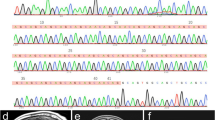Abstract
Dentatorubro-pallidoluysian atrophy (DRPLA) is a spinocerebellar ataxia (SCA) very rare in non-Asian populations. To date, DRPLA was undetected in the general Brazilian population. Adult-onset ataxic patients have been recruited from several Brazilian neurology and neurogenetics centers. CAG lengths at SCA1, SCA2, SCA3/MJD, SCA6, SCA7, SCA12, SCA17 and DRPLA associated genes, and ATTCT expansions at SCA10 gene were studied. A single DRPLA case detected is reported. Proband was a 69-year-old Brazilian woman of mixed ancestry, with a late-onset pure ataxia: her alleles at the associated gene, ATN1, presented 14/52 CAG repeats. History of gait ataxia and dementia was observed in two out of six siblings but was absent in her parents. This was the single DRPLA diagnosis obtained from 700 Brazilian unrelated cases with adult-onset ataxia, 487 of them with clear autosomal dominant inheritance. DRPLA accounted for 0.14% of all adult-onset ataxia cases and for 0.2% of families with autosomal dominant inheritance. Normal CAG repeats at ATN1 had a median (range) of 14 (5–20) repeats in other 410 Brazilian chromosomes. DRPLA is quite rare in Brazilian SCA families, which is consistent with the lack of large normal alleles in our population.


Similar content being viewed by others
References
Filla A, Mariotti C, Caruso G, Coppola G, Cocozza S, Castaldo I, et al. Relative frequencies of CAG expansions in spinocerebellar ataxia and dentatorubropallidoluysian atrophy in 116 Italian families. Eur Neurol. 2000;44(1):31–6.
Le Ber I, Camuzat A, Castelnovo G, Azulay JP, Genton P, Gastaut JL, et al. Prevalence of dentatorubral-pallidoluysian atrophy in a large series of white patients with cerebellar ataxia. Arch Neurol. 2003;60(8):1097–9.
Paradisi I, Ikonomu V, Arias S. Spinocerebellar ataxias in Venezuela: genetic epidemiology and their most likely ethnic descent. J Hum Genet. 2016;61(3):215–22.
de Souza PV, Batistella GN, Pinto WB, Oliveira AS. Teaching NeuroImages: leukodystrophy and progressive myoclonic epilepsy disclosing DRPLA. Neurology. 2016;86(6):e58–9.
Bird TD. Hereditary Ataxia Overview. 1998 Oct 28 [Updated 2016 Mar 3]. In: Pagon RA, Adam MP, Ardinger HH, et al., editors. GeneReviews® [Internet]. Seattle (WA): University of Washington, Seattle; 1993–2016. Available from: https://www.ncbi.nlm.nih.gov/books/NBK1138/
de Castilhos RM, Furtado GV, Gheno TC, Schaeffer P, Russo A, Barsottini O, et al. Spinocerebellar ataxias in Brazil—frequencies and modulating effects of related genes. Cerebellum. 2014 Feb;13(1):17–28. doi:10.1007/s12311-013-0510-y.
Bertolucci PH, Brucki SM, Campacci SR, Juliano Y. The mini-mental state examination in a general population: impact of educational status. Arq Neuropsiquiatr. 1994;52(1):1–7.
Castilhos RM, Souza AF, Furtado GV, Gheno TC, Silva AL, Vargas FR, et al. Huntington disease and Huntington disease-like in a case series from Brazil. Clin Genet. 2014;86(4):373–7. doi:10.1111/cge.12283.
Lopes-Cendes I, Teive HG, Calcagnotto ME, Da Costa JC, Cardoso F, Viana E, et al. Frequency of the different mutations causing spinocerebellar ataxia (SCA1, SCA2, MJD/SCA3 and DRPLA) in a large group of Brazilian patients. Arq Neuropsiquiatr. 1997;55(3B):519–29.
Teive HA, Munhoz RP, Arruda WO, Lopes-Cendes I, Raskin S, Werneck LC, Ashizawa T. Spinocerebellar ataxias: genotype-phenotype correlations in 104. Brazilian families Clinics (Sao Paulo). 2012;67(5):443–9.
Cintra VP, Lourenço CM, Marques SE, de Oliveira LM, Tumas V, Marques Jr W. Mutational screening of 320 Brazilian patients with autosomal dominant spinocerebellar ataxia. J Neurol Sci. 2014 Dec 15;347(1–2):375–9. doi:10.1016/j.jns.2014.10.036.
Serqueiros J, Martins S, Silveira I. Epidemiology and population genetics of degenerative ataxias. Handb Clin Neurol. 2012;103:227–51. doi:10.1016/B978-0-444-51892-7.00014-0.
Pujana MA, Corral J, Gratacòs M, Combarros O, Berciano J, Genís D, et al. Spinocerebellar ataxias in Spanish patients: genetic analysis of familial and sporadic cases. The Ataxia Study Group Hum Genet. 1999 Jun;104(6):516–22.
Coutinho P, Ruano L, Loureiro JL, Cruz VT, Barros J, Tuna A, et al. Hereditary ataxia and spastic paraplegia in Portugal: a population-based prevalence study. JAMA Neurol. 2013 Jun;70(6):746–55. doi:10.1001/jamaneurol.2013.1707.
Wardle M, Morris HR, Robertson NP. Clinical and genetic characteristics of non-Asian dentatorubral-pallidoluysian atrophy: a systematic review. Mov Disord. 2009 Aug 15;24(11):1636–40.
Munhoz RP, Bergeron C, Lang AE. Sporadic case of dentatorubral pallidoluysian atrophy with no CAG repeat expansion and no intranuclear inclusions. Mov Disord. 2004 May;19(5):580–3.
Takano H, Cancel G, Ikeuchi T, Lorenzetti D, Mawad R, Stevanin G, et al. Close associations between prevalences of dominantly inherited spinocerebellar ataxias with CAG-repeat expansions and frequencies of large normal CAG alleles in Japanese and Caucasian populations. Am J Hum Genet. 1998;63:1060–6.
Veneziano L, Frontali M. DRPLA. 1999 Aug 6 [Updated 2016 Jun 9]. In: Pagon RA, Adam MP, Ardinger HH, et al., editors. GeneReviews® [Internet]. Seattle (WA): University of Washington, Seattle; 1993–2016. Available from: https://www.ncbi.nlm.nih.gov/books/NBK1491/
Acknowledgement
The authors would like to thank the families who agreed to participate in this study.
Author information
Authors and Affiliations
Consortia
Contributions
Conception or design of the work: PBN, JLP, MLSP, LBJ, OB. Acquisition, analysis, or interpretation of data for the work: PBN, JLP, GVF, TCG, MLSP, LBJ, OB.
Drafting the work or revising it critically for important intellectual content: PBN, JLP, GVF, TCG, MLSP, LBJ, OB.
Final approval of the version to be published: PBN, JLP, GVF, TCG, MLSP, LBJ, OB.
Agreement to be accountable for all aspects of the work in ensuring that questions related to the accuracy or integrity of any part of the work are appropriately investigated and resolved: PBN, JLP, GVF, TCG, MLSP, LBJ, OB.
Corresponding author
Ethics declarations
Conflict of Interests
The authors declare that they have no conflict of interest.
Funding
This work was supported by the following Brazilian agencies: FAPERGS—Fundação do Amparo à Pesquisa do Rio Grande do Sul—by the project 0700832 EDITAL PPSUS FAPERGS 006/2006; FIPE-HCPA—Fundo de Incentivo à Pesquisa do Hospital de Clínicas de Porto Alegre—by the Project GPPG HCPA 06–384; and by INAGEMP—Instituto Nacional de Genética Médica Populacional. PBN, MLSP, and LBJ were supported by CNPq—Conselho Nacional de Desenvolvimento Científico e Tecnológico.
Electronic supplementary material
ESM 1
(M4V 9422 kb)
Rights and permissions
About this article
Cite this article
Braga-Neto, P., Pedroso, J.L., Furtado, G.V. et al. Dentatorubro-Pallidoluysian Atrophy (DRPLA) among 700 Families with Ataxia in Brazil. Cerebellum 16, 812–816 (2017). https://doi.org/10.1007/s12311-017-0862-9
Published:
Issue Date:
DOI: https://doi.org/10.1007/s12311-017-0862-9




